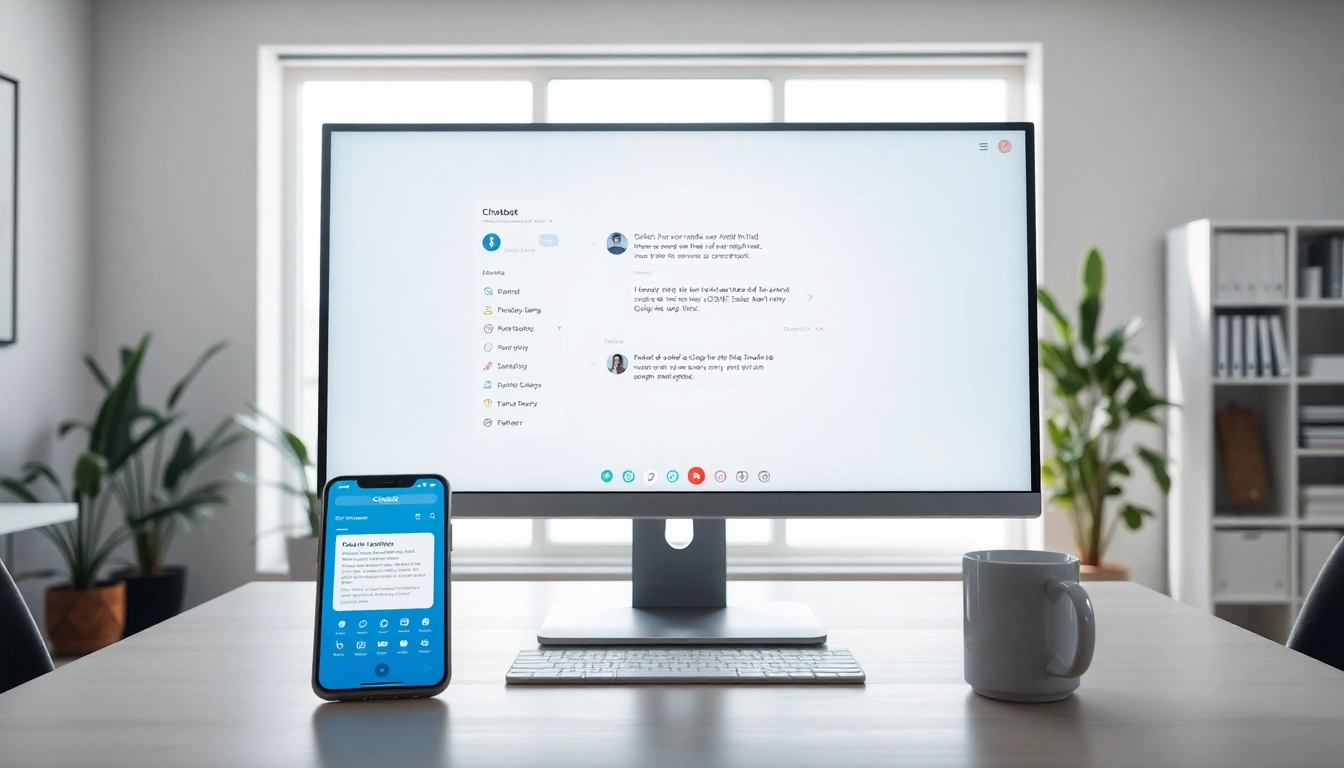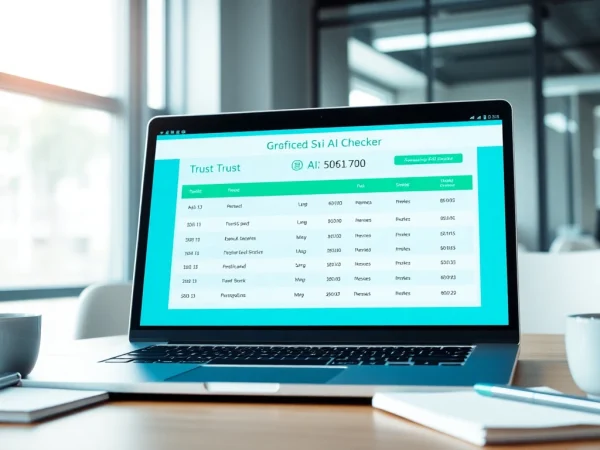Enhancing Customer Engagement with ChatGPT Chatbot Technology
Understanding the ChatGPT Chatbot
In the rapidly evolving digital landscape, businesses are increasingly turning to AI-driven solutions to enhance customer engagement and optimize operational efficiency. One such solution is the chatgpt chatbot, powered by the advanced capabilities of the ChatGPT model. This chatbot not only simplifies interactions with customers but also provides insightful data that can refine business strategies. In this article, we delve into the intricacies of the ChatGPT chatbot, exploring its features, benefits, and strategies for effective implementation.
What is a Chatbot?
At its core, a chatbot is an AI application designed to simulate human conversation through text or voice interactions. These digital assistants can engage with users in real-time, answering questions, providing support, and performing specific tasks. While basic chatbots are rule-based and function within a predefined script, advanced AI chatbots like ChatGPT utilize machine learning and natural language processing (NLP) to understand context and generate dynamic responses. This allows for more personalized and meaningful interactions, enhancing user satisfaction and engagement.
Key Features of ChatGPT Chatbot
The ChatGPT chatbot offers numerous features that set it apart from traditional chatbots:
- Natural Language Understanding: It can comprehend and respond in colloquial language, making interactions feel more genuine.
- Context-Aware Conversations: The chatbot retains context from previous exchanges, allowing for fluid conversations that mimic human dialogue.
- Scalability: It can handle multiple conversations simultaneously, making it ideal for businesses looking to maintain high levels of customer service without increasing personnel costs.
- Learning and Adaptability: The model continuously learns from each interaction, improving its responses over time based on user feedback.
- Integration Capabilities: ChatGPT can seamlessly integrate with other systems such as CRMs and databases, enhancing its functionality and utility.
Benefits of Implementing a ChatGPT Chatbot
Incorporating a ChatGPT chatbot into business operations offers multiple advantages:
- Enhanced Customer Experience: With instant responses and 24/7 availability, customers feel valued and connected regardless of the time of day.
- Cost Reduction: Automating customer interactions reduces the need for extensive customer service teams, resulting in significant cost savings.
- Increased Efficiency: Chatbots can assist with routine queries, allowing human agents to focus on more complex issues and improving overall productivity.
- Data Collection: By analyzing interactions, businesses can gather valuable insights about customer preferences and behavior, informing future strategies.
- Brand Consistency: Chatbots provide uniform responses, ensuring that every customer receives the same quality of service, which fosters trust and reliability.
Creating Effective Chatbot Interactions
Creating effective interactions with a ChatGPT chatbot requires careful consideration of conversational design, user experience, and the full capabilities of the model.
Designing Conversational Flows
A well-designed conversational flow is crucial for maintaining user engagement. Start by identifying common user intents and tailoring the conversation around those. This can be achieved by:
- Mapping User Journeys: Understand the typical paths users take when interacting with your service and structure the conversation to guide them smoothly through the process.
- Using Branching Dialogs: Include decision points in the conversation where users can choose what they would like to know next, making the interaction feel more personalized.
- Incorporating Rich Media: Enhance conversations with images, videos, or buttons that allow users to navigate through options seamlessly, providing a richer experience.
Personalizing User Experience
Personalization is key to customer satisfaction. Utilizing user data, you can customize chatbot interactions by:
- Addressing Users by Name: Simple gestures like mentioning the user’s name can significantly enhance the relatability of the interaction.
- Recommending Products: Use insights from previous purchases to suggest products or services that align with user interests, thereby driving sales conversions.
- Understanding User Preferences: Collect data on user interactions to tailor future conversations, ensuring that the chatbot becomes more relatable over time.
Utilizing ChatGPT Model Capabilities
Leverage the full potential of the ChatGPT model by continuously enhancing its capabilities through:
- Feedback Loops: Incorporate user feedback to refine responses and improve accuracy. Ensuring the chatbot learns from its mistakes is crucial for maintaining quality.
- Natural Language Generation: Craft responses that reflect a conversational tone, utilizing the model’s advanced language generation capabilities for more engaging dialogues.
- Scenario Testing: Regularly test the chatbot in various scenarios to identify areas for improvement and ensure it handles diverse queries effectively.
Implementation Strategies for Businesses
Successfully implementing a ChatGPT chatbot within your organization requires careful planning and execution. Here are key strategies to consider:
Preparing Your Technical Environment
Before deploying a ChatGPT chatbot, ensure that your technical environment is adequately prepared. This includes:
- Infrastructure Assessment: Ensure sufficient server capacity and bandwidth to handle potential spikes in traffic, especially during peak times.
- API Integrations: Determine the necessary APIs for integrating the chatbot with your customer management systems and other digital platforms.
- Security Protocols: Implement strong security measures to protect sensitive customer data and comply with regulations such as GDPR.
Integrating ChatGPT with Existing Systems
To maximize the effectiveness of your ChatGPT chatbot, integration with existing systems is essential. Key steps include:
- Connecting with CRM Systems: Link the chatbot to your customer relationship management system to access user data and provide tailored responses.
- Embedding in Communication Channels: Integrate your chatbot across multiple platforms such as websites, social media, and messaging apps to enhance reach.
- Monitoring and Logging: Set up systems to monitor chatbot interactions and log data for performance analysis and quality control.
Training Your Chatbot
A well-trained chatbot is essential for achieving high user satisfaction. Training involves:
- Utilizing Historical Data: If available, use past conversations to train the model on common queries and responses. This provides a solid foundation for initial interactions.
- Simulating Conversations: Conduct mock conversations with the chatbot to identify weaknesses in understanding and response quality, allowing for iterative improvements.
- Regularly Updating Knowledge Bases: Ensure that the chatbot has access to the latest information and resources to provide accurate answers to user queries.
Measuring Performance and Usage
To ensure that your ChatGPT chatbot is meeting business objectives, it’s vital to implement robust performance measurement strategies. This will enable continual assessment and refinement of its operations.
Key Metrics for Chatbot Success
Critical performance metrics to consider include:
- Response Time: Measure how quickly the chatbot provides answers to user inquiries, with the goal of minimizing wait times.
- User Satisfaction Scores: Utilize surveys post-interaction to assess user satisfaction and identify areas for improvement.
- Conversation Completion Rates: Track how often users achieve their goals in conversations with the chatbot, indicating its effectiveness.
- Fallback Rates: Monitor scenarios where users are directed to human agents, as high rates can indicate shortcomings in the chatbot’s capabilities.
Gathering User Feedback
User feedback is invaluable for continuous improvements. To systematically gather feedback:
- Post-Interaction Surveys: Implement quick surveys after conversations to collect insights on user experiences and areas that could be enhanced.
- Direct Feedback Channels: Enable users to provide suggestions and share their frustrations directly within the chat interface.
- Analyzing Conversation Logs: Regularly review chat logs to identify trends, common complaints, and opportunities for improvement.
Continuous Improvement for Better Engagement
To maintain engagement and user satisfaction, consider implementing a strategy of continuous improvement by:
- Regular Updates: Frequently update the chatbot’s training data based on new information, trends, or shifts in user expectations.
- A/B Testing: Test different conversational strategies, user flows, or engagement tactics to determine the most effective approaches.
- Flexibility in Design: Ensure that the chatbot can evolve with changing business needs and user preferences, refining its approach as necessary.
Future Trends in Chatbot Technology
The landscape of chatbot technology is continuously advancing, driven by innovations in AI and machine learning. Staying ahead of these trends will position businesses for success in a competitive market.
Advancements in AI and Machine Learning
The future of chatbots is significantly influenced by advancements in AI and machine learning technologies, including:
- Enhanced Natural Language Processing: Future models will understand context, emotion, and nuances in language even better, resulting in more human-like interactions.
- Emotion Recognition: AI systems are being developed to recognize and respond to user emotions, allowing for more empathetic interactions that build rapport.
- Predictive Analytics: Chatbots will increasingly use predictive insights to proactively address user needs, anticipating customer inquiries before they arise.
Potential Applications Beyond Customer Service
While customer service remains a prominent application, the potential uses of chatbots continue to expand into areas such as:
- Personal Assistants: Chatbots can schedule appointments, manage calendars, and remind users of important tasks, functioning as personal virtual assistants.
- Educational Tools: AI chatbots can serve as tutors or guides, assisting learners in various subjects and adapting teaching methods to individual learning styles.
- Healthcare Support: In healthcare, chatbots can facilitate symptom checking, appointment scheduling, and provide timely health information to patients.
Preparing for the Future of Chatbots
To prepare for the future of chatbot technology, businesses should focus on:
- Investing in AI Training: Ensuring that teams are skilled in AI and machine learning to effectively implement and manage chatbot systems.
- Staying Updated with Trends: Following industry advancements and integrating new features that enhance chatbot capabilities.
- Fostering a Culture of Innovation: Encouraging team members to explore creative chatbot applications, aligning with evolving customer expectations.










